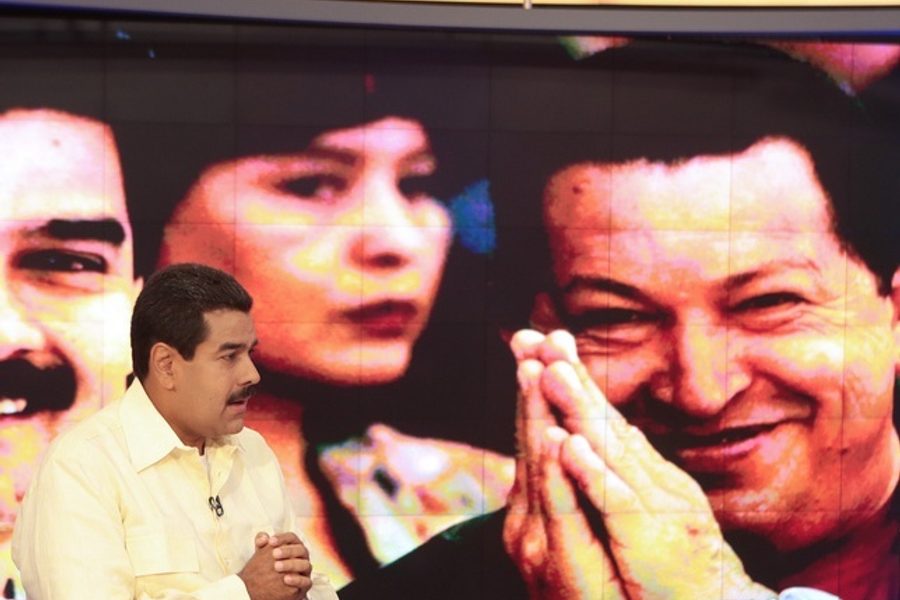Tapping Chavez’s Political Reserves
Sunday’s presidential election in Venezuela will test the political infrastructure of Bolivarian Revolution.
Jackson Foote and Luis D. Lucas

With Venezuelans preparing to go to the polls in the highly anticipated election to replace the late president Hugo Chávez, both candidates held massive rallies in Caracas on Thursday as campaigning closed.
Interim President Nicolás Maduro is expected to win Sunday’s election handily, currently polling at 17 points ahead of opposition candidate Henrique Capriles, despite Capriles’ charges that Maduro has no real experience.
Given the contentious partisan rhetoric and the Venezuela’s decade-long escalation of violence, especially in Caracas, things are understandably tense. Though each side called for peace following the late president’s death, the slim possibility of a Capriles win has proved unsettling for supporters of the United Socialist Party, which has controlled politics for a generation.
As the handpicked successor to the late populist president, Maduro should benefit greatly from the pomp and circumstance that has surrounded Chávez’s memorial celebrations. He should also be able to ride the wave of political momentum from last year’s sextennial election that Chávez won decisively. Indeed, the shadow of the former president looms large over this election, and Nicolás Maduro has taken advantage of the moment, trying to keep the memory of his predecessor alive. Last month he suggested that Chávez might have influenced the papal nomination of a fellow South American from beyond the grave. More recently, Maduro claimed Chávez visited him in the form of a bird. This relentless messaging from a campaign intent on sustaining continuity has even inspired the creation of a website to track the daily use of Chávez’s name by the Maduro campaign.
This special election is not so much a referendum on the Bolivarian Revolution, as the past two elections have been. Rather, it is a vote on the legacy of Chávez’s political infrastructure and whether that infrastructure can withstand the loss of his dominating personality.
After Chávez’s death, many observers of Latin America compared his legacy to that of Juan Perón, three-term president of Argentina. Much like his Argentine counterpart, Chávez mobilized around the country’s poor and maintained their support by giving away billions. But whereas Perón eventually alienated his base, Chávez was still popular at the time of his death, winning his last election just four months before by a margin of nine percent.
The state and the party had relied on the popularity of the president, who dominated the political landscape for 15 years. Now, the Venezuelan Socialist Party will have to invert that relationship, and the president will rely on popularity of the party and the ability of the state to deliver. Thus the election will bring to the foreground the political organization of the Socialist Party as much as the personality of a hopeful Maduro.
Chávez built institutional power through social programs, consolidation of party apparatus, restriction on opposition media, and control of legal authorities. But the apparatus that Chávez built may not be able to produce the same results posthumously — members of congress do not hold the same sort of sway or legitimacy with the public. That said, the next congressional election won’t come until 2015 and the new president’s term will not end until 2019, which will give them some time to bolster their popularity.
In a country that has become accustomed to oil-funded social programs, one strategy is to continue using oil revenue to provide necessities and housing assistance to the country’s poor. Venezuela’s reserves are strong and will stay that way for decades, despite the fact that many critique Chávez for creating long-term structural problems for the state oil company. Capriles, in contrast, promises to encourage free-market economic practices, embracing a model akin to former Brazilian president Luiz Inácio Lula da Silva. His final appeal to voters was direct. “I ask you for the opportunity to show that I can indeed govern and make things right,” Capriles told supporters at a rally in Caracas.
But if the turnout matches the polls, Venezuela will likely stay left. The real question is what happens after that.




